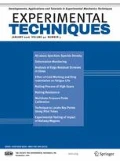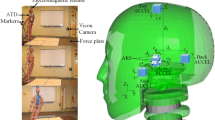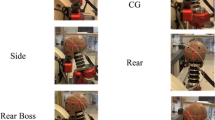Abstract
A test method based upon a Hybrid-III head and neck assembly that includes measurement of both linear and angular acceleration is investigated for potential use in impact testing of protective headgear. The test apparatus is based upon a twin wire drop test system modified with the head/neck assembly and associated flyarm components. This study represents a preliminary assessment of the test apparatus for use in the development of protective headgear designed to prevent injury due to falls. By including angular acceleration in the test protocol it becomes possible to assess and intentionally reduce this component of acceleration. Comparisons of standard and reduced durometer necks, various anvils, front, rear, and side drop orientations, and response data on performance of the apparatus are provided. Injury measures summarized for an unprotected drop include maximum linear and angular acceleration, head injury criteria (HIC), rotational injury criteria (RIC), and power rotational head injury criteria (PRHIC). Coefficient of variation for multiple drops ranged from 0.4 to 6.7 % for linear acceleration. Angular acceleration recorded in a side drop orientation resulted in highest coefficient of variation of 16.3 %. The drop test apparatus results in a reasonably repeatable test method that has potential to be used in studies of headgear designed to reduce head impact injury.
Similar content being viewed by others
References
ASTM F1446 - 11a. “Standard Test Methods for Equipment and Procedures Used in Evaluating the Performance Characteristics of Protective Headgear,” ASTM International, West Conshohocken, PA (2011). doi:10.1520/F1446-11A.
Rakier, A., Guilburd, J.N., Soustiel, J.F., Zaaroor, M., and Feinsod, M., “Head Injuries in the Elderly,” Brain Injury 9:187–194 (1995).
Nahum, A.M., Gatts, J.D., Gadd, C.W., and Danforth, J., “Impact Tolerance of the Skull and Face. 12th STAPP Car Crash Conference Proceedings (SAE 680785) (1968),” Backaitis, S.H., (ed), Biomechanics of Impact Iniurv and Iniurv Tolerances of the Head-Neck Complex, Society of Automotive Engineers, Warrendale, PA, p. PT43:1152 (1993).
Caccese, V., Ferguson, J.R., and Edgecomb, M.A., “Optimal Design of Honeycomb Material Used to Mitigate Head Impact,” Composite Structures 100:404–412 (2013).
Hardman, J.M., and Manoukian, A., “Pathology of Head Trauma,” Euroimaging Clinics of North America 12:175–187 (2002).
Thibault, L.E., Gennarelli, T.A., “Biomechanics of Diffuse Brain Injuries,” Tenth International Technical Conference on Experimental Safety Vehicles, SAE 856022 Washington, DC (1985).
Gennarelli, T. A.: Head injury biomechanics: a review. In: M. Macklay, H. Millander, S. Nilsson and E. Petrucelli (editors) Head Injury Mechanisms: Symposium Report (Association for the Advancement of Automotive Medicine, Des Plaines), Pages 9–22, (1987).
DiMassi, F.P, Eppinger, R.H., and Bandak, F.A., “Computational Analysis of Head Impact Response under Car Crash Loadings,” 39th Stapp Car Crash Conference, pp. 425–438 (1985).
Yoganandan, N., Li, J., Zhang, F., Pintar, F.A., and Gennarelli, T.A., “Influence of Angular Acceleration-Deceleration Pulse Shapes on Regional Brain Strains,” Journal of Biomechanics 41:2253–2262 (2008).
King, A.I., Yang, K.H., Zhang, L., Hardy, W., and Viano, D.C., “Is Head Injury Caused by Linear or Angular Acceleration,” International Research Conference on the Biomechanics of Impact (IRCOBI), Lisbon, Portugal (2003).
Kimpara, H., Nakahira, Y., Iwamoto, M., Rowson, S., and Duma, S., “Head Injury Prediction Methods Based on 6 Degree of Freedom Head. Acceleration Measurements during Impact,” International Journal of Automotive Eng 2:3–19 (2011).
Digges, K., “Injury Measurements and Criteria,” AGARD Conference on Biomechanics Dayton, OH (1998).
Versace J. A review of the severity index. Proceedings of the 15th Stapp Car Crash Conference Society of Automotive Engineers, New York, pp. 771–796 (1971).
Gadd C.W., “Use of a weighted-impulse criterion for estimating injury hazard,” Proceedings of the 10th Stapp Car Crash Conference on Society of Automotive Engineers, New York, pp. 164–174 (1966).
Snell B-95 standard, Standard for Protective Headgear for Use with Bicycles, http://www.smf.org/standards/b/b95std, Snell Memorial Foundation, Inc, St.James, NY (1995).
Holbourn, A.H.S., “Mechanics of head injuries,” Lancet ii:438–441 (1943).
Gurdjian, E.S., Webster, J.E., and Lissner, H.R., “Observations on prediction of fracture site in head injury,” Radiology 60:226–235 (1953).
Ommaya, A.K., and Hirsch, A.E., “Tolerances for Cerebral Concussion from Head Impact and Whiplash in Primates,” Journal of Biomechanics 4:13 (1971).
Newman, J.A., “A Generalized Model for Brain Injury Threshold (GAMBIT),” International Conference on the Biomechanics of Impact (IRCOBI) Zurich, Switzerland (1986).
Newman, J.A., Shewchenko, N., Welbourne, E., “A Proposed New Kinematic Head Injury Assessment Function - The Maximum Power Index”. The 44th Stapp Car Crash Conference Atlanta, GA (2000).
Newman, J.A., Barr, C., Beusenberg, M., Fournier, E., Shewchenko, N., Welbourne, N., and Withnall, C., “A New Biomechanical Assessment of Mild Traumatic Brain Injury Part 2 – Results and Conclusions,” International Research Conference on the Biomechanics of Impact (IRCOBI), pp. 223–233 (2000).
Yoganandan, N., Pintar, F.A., Sances, A., Jr., et al., “Biomechanics of skull fractures,” Journal of Neurotrauma 12:659–668 (1995).
Lesko, M.M., Woodford, M., White, L., O’Brien, S.J., Childs, C., and Lecky, F., “Using Abbreviated Injury Scale (AIS) Codes to Classify Computed Tomography (CT) Features in the Marshall System,” BMC Med Res Methodol 10:72 (2010).
Eppinger, R., Sun, E., Kuppa, SH., and Saul, R., “Supplement: Development of Improve Injury Criteria for the Assessment of Advanced Automotive Restraint Systems -II,” I-ITSA (2000).
Fenner, H. Jr., Thomas, D.J., Gelmarelli, T., Pintar, F.A., Becker, E.B., Newman, J.A., Yoganandan N, Patlak, M., “Report of Workshop on Criteria for Head Injury and Helmet Standards,” Medical College of Wisconsin and Snell Memorial Foundation, Inc., Milwaukee, Wisconsin, (2005).
Zhang, L., Yang, K.H., and King, A.I., “A Proposed Injury Threshold for Mild Traumatic Brain Injury,” Transactions of the ASME 126:226–236 (2004).
Funk, J.R., Duma, S.M., Manoogian, S.J., and Rowson, S., “Biomechanical Risk Estimates for Mild Traumatic Brain Injury,” Annual Proceedings - Association for the Advancement of Automotive Medicine 51:343–361 (2007).
Funk, J.R., Rowson, S., Daniel, R.W., and Duma, S.M., “Validation of Concussion Risk Curves for Collegiate Football Players Derived from HITS Data,” Annals of Biomedical Engineering 40(1): 79–89 (2011).
Rowson, S., and Duma, S.M., “Development of the STAR Evaluation System for Football Helmets: Integrating Player Head Impact Exposure and Risk of Concussion,” Annals of Biomedical Engineering 39(8): 130–140 (2011).
Rowson, S., and Duma, S.M., “Brain Injury Prediction: Assessing the Combined Probability of Concussion Using Linear and Rotational Head Acceleration,” Annals of Biomedical Engineering, Biomedical Engineering Society 41(5): 873–82 (2013).
O’Riordain, K., Thomas, P.M., Phillips, J.P., and Gilchrist, M.D., “Reconstruction of Real World Injury Accidents Resulting From Falls Using Mulitbody Dynamics,” Clinical Biomechanics 18:590–600 (2003).
Doorly, M.C., Phillips, J.P., and Gilchrist, M.D., “Reconstructing Real Life Accidents Towards Establishing Criteria for Traumatic Head Impact Injuries,” IUTAM Proceedings on Biomechanics, from Fundamental Insights to Applications Solid Mechanics and Its Applications 124:81–90 (2005).
Hardy, W.N., Mason, M.J., Foster, C.D., et al., “A Study of the Response of the Human Cadaver Head to Impact,” Stapp Car Crash J 51:17–80 (2007).
SAE J211/1, “Instrumentation for Impact Test - Part 1 – Electronic Instrumentation,” Society of Automotive Engineers International, Surface Vehicle Recommended Practice, Warrendale, PA (2007).
Lloyd, J., “Tailored Medical Helmets for Specific Patient Populations and Co-Morbidities,” Progress Report submitted to Alba-Technic, LLC, Traumatic Brain Injury Lab, James A. Haley VA Hospital, August (2012).
Walsh, E.S., Rousseau, P., and Hoshizaki, T.B., “The Influence of Impact Location and Angle on the Dynamic Response of a Hybrid III Headform,” Sports Engineering 13:135–143 (2011).
Federal Motor Vehicle Safety Standard No. 218, “Motorcycle Helmets,” 49 CFR 571.218, U.S. Department of Transportation, National Highway Traffic Safety Administration (2011).
NOCSAE DOC (ND) 001- 11 m11, “Standard Test Method and Equipment Used in Evaluating the Performance Characteristics of Protective Headgear/Equipment,” National Operating Committee on Standards for Athletic Equipment, Overland Park, KS (2011).
ASTM F429-10, “Standard Test Method for Shock-Attenuation Characteristics of Protective Headgear for Football,” ASTM International, West Conshohocken, PA (2007).
NOCSAE DOC (ND) 021- 11 m12, “Standard Projectile Impact Testing Method and Equipment Used in Evaluating the Performance Characteristics of Protective Headgear, Faceguards or Projectiles,” National Operating Committee on Standards for Athletic Equipment, Overland Park, KS (2012).
Halldin, P., Gilchrist, A., and Mills, N.J., “A New Oblique Impact Test for Motorcycle Helmets,” International Journal of Crashworthiness 6(1): 53–64 ISSN 1358–8265 (2001).
Mills, N.J., and Gilchrist, A., “Response of Helmets in Direct and Oblique Impacts,” International Journal of Crashworthiness 2:7–23 (1996).
Moss, W.C., King, M.J., “Football Helmet Report Impact Response of US Army and National Football League Helmet Pad Systems,” Lawrence Livermore Laboratory Report, No. LLNL-SR-471496 (2011).
Bartsch, A., Benzel, E., Miele, V., Morr, D., and Prakash, V., “Hybrid III Anthropomorphic Test Device (ATD) Response to Head Impacts and Potential Application for Athletic Head Gear Testing,” Accident Analysis and Prevention 48:285–291 (2012).
Mertz, H., Patrick, L., “Strength and Response of the Human Neck,” 15th Stapp Car Crash Conference, San Diego, California, Society of Automotive Engineers, Inc., Warrendale, PA (1971).
Mertz, H., “Biofidelity of the Hybrid III Head,” SAE Technical Paper 851245 (1985).
Herbst B., Forrest S., Chng D., Sances A., “Fidelity of Anthropometric Test Dummy Necks in Rollover Accidents,” Paper No. 98-S9-W-20, Sixteenth International Technical Conference on the Enhanced Safety of Vehicles (ESV), (1998).
Yi, S.-I., Mohan, P.K., Kan, C.-D., and Park, G.J., “Finite Element Modelling of a Hybrid III Dummy and Material Identification for Validation,” Proceedings of the Institution of Mechanical Engineers, Part D: Journal of Automobile Engineering January 1(225): 54–73 (2011).
Kendall, M., Walsh, E.S., and Hoshizaki, T.B., “Comparison Between Hybrid III and Hodgson − WSU Headforms by Linear and Angular Dynamic Impact Response,” Proceedings of the Inst of Mechanical Engineers, Part P: Journal of Sports Engineering and Technology 226:260–265 (2012).
ASTM F2439 – 06, “Standard Specification for Headgear Used in Soccer,” ASTM International, West Conshohocken, PA (2011). doi:10.1520/F2439-06R11
SAE J1733, “Sign Convention for Vehicle Crash Testing,” Society of Automotive Engineers International, Surface Vehicle Recommended Practice, Warrendale, PA (1994).
Padgaonkar, A.J., Krieger, K.W., and King, A.I., “Measurement of angular acceleration of a rigid body using linear accelerometers,” Journal of Applied Mechanics 42:552–556 (1975).
Author information
Authors and Affiliations
Corresponding author
Rights and permissions
About this article
Cite this article
Caccese, V., Ferguson, J., Lloyd, J. et al. Response of an Impact Test Apparatus for Fall Protective Headgear Testing Using a Hybrid-III Head/Neck Assembly. Exp Tech 40, 413–427 (2016). https://doi.org/10.1007/s40799-016-0046-4
Published:
Issue Date:
DOI: https://doi.org/10.1007/s40799-016-0046-4




